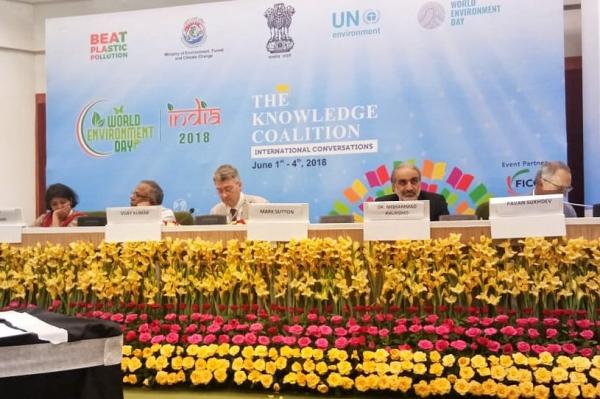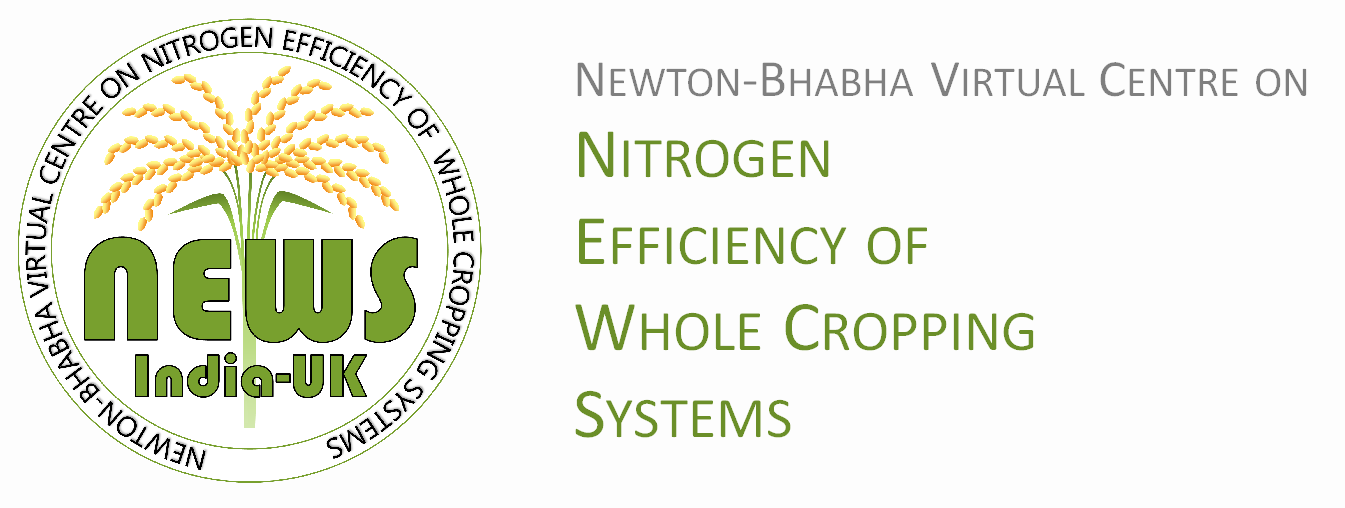Nitrogen: Joining up for a cleaner environment
The panel discussion session “Nitrogen: Joining up for a cleaner environment”, is the first ever nitrogen session hosted by the Indian government. The event was held as part of the 5-day celebration of World Environment Day 2018 at Vigyan Bhavan, New Delhi, on June 4. The session was created based on input from the International Nitrogen Initiative, the Indian Nitrogen Group, Sustainable India Trust and the UN Environment’s India office, along with the Sustainable India Finance Facility (SIFF).
The session was chaired by Prof. Mark Sutton (Centre for Ecology & Hydrology, UK), Director of the International Nitrogen Management System (INMS). The other panellists in the session were:
- Prof. Nandula Raghuram, President of the Indian Nitrogen Group, Trustee of the Sustainable India Trust and Dean of School of Biotechnology, GGS Indraprastha University (GGSIPU);
- Pavan Sukhdev, President of WWF International;
- Vijay Kumar, Senior Advisor to the Dept. of Agriculture and Cooperation of the Govt. of Andhra Pradesh and Head of its Zero Budget Natural Farming Programme;
- Dr. Mohammad Khurshid, Director of the South Asia Co-operative Environment Programme (SACEP); and
- Urmi Goswami, Journalist at The Economic Times, an English language financial daily newspaper based in New Delhi.

India: A global hotspot for ammonia emission
Prof. Mark Sutton highlighted the importance of the management of reactive nitrogen along with air, water, soil, plastics and waste management to meet the goal of a cleaner environment. He explained that as fertiliser, reactive nitrogen is vital for agriculture to ensure food security. However, the unused reactive N compounds, lost to environment, leads to water, air and soil pollution, whilst worsening also climate change. Prof. Sutton said that a mere 20% improvement in N use efficiency could potentially save fertiliser worth around 23 USD billion/year globally, of which 3, 3 and 6 billion USD could be saved by India, the United States and China, respectively. He underscored the importance of nitrogen assessment at national, regional and global levels, under the UNEP Global Partnership on Nutrient Management and the International Nitrogen Management System. Putting the Nitrogen Session into context, he added that India is a global hotspot for ammonia emission, along with outstandingly high emissions of nitrous oxide and NOx. These losses are worth 7 billion USD of unused fertiliser, whereas the direct and indirect environmental costs could go up to 12 billion dollars.
Director of INMS, Prof. Mark Sutton on the podium at @WED2018India, opening the Nitrogen Session.#Nitrogen4WED #WED2018 @CEHScienceNews pic.twitter.com/uLLoYRricF
— Towards INMS (@TowardsINMS) June 4, 2018
Agriculture: Victim and ally of climate change
Prof. Raghuram said that India is one of the few countries in the world that has carried out its own scientific assessment of reactive nitrogen, published recently in the book “Indian Nitrogen Assessment”. He acknowledged the efforts of the scientists of the Indian Nitrogen Group, who, in lack of any specific funding, devoted their time and effort from pure passion for nitrogen. Presenting the key findings of the book, Prof. Raghuram explained that agriculture is not only a victim of climate change but also contributes to it. In India, agriculture is the source of over 61% of all forms of reactive N, followed by fuels and sewage. Over 77% of the agricultural N originates from synthetic N fertiliser, of which 70% is used for food production, mainly rice and wheat. It is not widely known that over the last 15 years, nitrous oxide emitted from fertiliser use has replaced methane as the 2nd most important greenhouse gas after CO2. Prof. Raghuram added that according to the latest FAI data, fertilizer consumption in India has been tapering off. This is clear result of the Indian government’s recent policy, mandating that neem-coated urea can be the only urea to be sold in India, and reducing the urea bag size by 10%, demonstrating the important role and impact of decisive policy interventions. However, he said, sewage, residue burning and clean fuels should also be the focus for sustainable N management.
Prof. Raghuram from Indraprastha University gave an overview of the Indian Nitrogen Assesment, an initiative from scientists sharing their passion for #nitrogen.#Nitrogen4WED #WED2018 @WED2018India pic.twitter.com/hjFkJoy1ZA
— Towards INMS (@TowardsINMS) June 4, 2018
Farming without synthetic fertilisers?
Mr. Vijay Kumar, provided a brief overview of the Zero Budget Natural Farming (ZBNF) adopted by the state governement of Andhra Pradesh. As he explained, ZBNF does not use any synthetic fertilisers and other agrochemicals and is based on the Japanese concept of natural farming as well as the Australian concept of regenerative agriculture and agroecology. Such methods have been tried earlier on a small scale in many places, including in the Indian state of Karnataka with some success, but officially, for the first time, it was adopted the by the state government of Andhra Pradesh in South India. It involves the development and use of bioinoculants (with biofertilisers, such as dung and urine) and spraying them on the farm soil to stimulate microbial growth for soil nitrogen mobilization. Seeds are also coated with microbial inoculants. So far, ZBNF has been adopted by 130,000 farmers over about 150,000 hectares of land. The state government plans to target 6 million farmers by 2025 and eventually, cover the entire state.
The farmers are the best scientists as they work closely with nature - Vijay Kumar #WED2018 #agriculture pic.twitter.com/Pu41R1aCWP
— World Environment Day (@WED2018India) June 4, 2018
A nitrogen resolution
Dr. Mohammad Khurshid described the pivotal role of SACEP to foster regional environmental cooperation among member countries of the South Asian Association for Regional Cooperation (SAARC) to recognize and address the issue of nutrient pollution in the South Asian seas and to aid the South Asian nitrogen assessment under the International Nitrogen Management System. He emphasized the role of SACEP in drafting and promoting a nitrogen resolution in the UN Environment assembly. Dr. Khurshid added that a policy instrument on reactive nitrogen management is essential for every government to strike a balance between N fertilizers for agricultural productivity and their adverse environmental impacts. To achieve the goal of sustainable development and to ensure food and feed security, sustainable consumption should be in line with the sustainable production.
Dr. Mohammad Khurshid from @OrgSacep also mentioned the draft #nitrogen resolution to be submitted to @UN.#WED2018 @WED2018India #Nitrogen4WED pic.twitter.com/TTSB133ylz
— Towards INMS (@TowardsINMS) June 4, 2018
Urgent call for public engagement
Urmi Goswami pointed out that nitrogen pollution has not received yet the public attention it deserves, and that society is unaware of its implications unlike plastics pollution and air pollution. She advocated wider public engagement to ensure greater awareness and public acceptability to the initiatives in N pollution management. This could also help to generate the willingness among the policymakers to look at the solutions required to tackle N pollution. To bring the desired recognition and foster change at the grassroots level, she said, a more active participation from NGOs, media and other civil society stakeholders is necessary.
Why is the public not aware of the effects of N pollution? - asks @urmiagoswamiET from @EconomicTimes the panel of the #Nitrogen Session. Clearly, there is a lot to do! First steps has been made with the Nitrogen MOOC: https://t.co/5DPqeBDZOi#WED2018 #Nitrogen4WED @WED2018India pic.twitter.com/dzancUkkDH
— Towards INMS (@TowardsINMS) June 4, 2018
The challenges of environmental advocacy
Pawan Sukhdev was speaking about the environmental economics and methodological aspects of evaluating environmental costs. He argued that such estimations can be improved if we understand the differences between countries and populations and how they value their environment and how much they can afford to pay for it. Mr. Sukhdev also highlighted the challenges faced by environmental advocacy: the externalities, the power of incumbency and the ‘not made in here’ (NMIH) approaches, all causing delays in formulating and implementing policies.
@PavanSukhdev president of @WWF on how to evaluate #nitrogen.#Nitrogen4WED #WED2018 @WED2018India pic.twitter.com/fpRt5QVr5f
— Towards INMS (@TowardsINMS) June 4, 2018
Conclusions
After a vivid open discussion, the session concluded with the following consensus:
- More scientific evidence with more recent data across sectors and countries would help a better understanding of the scale of the impacts of nitrogen pollution, as well as the impacts of policy measures/interventions.
- Scientific evidences should be translated and disseminated in a manner that the public can understand and appreciate. The Indian Nitrogen Group is encouraged to work with civil society to produce a summary of the Indian Nitrogen Assessment for broad consensus.
- Zero Budget Natural Farming (ZBNF) is fascinating from the point of view of nitrogen. However, it needs further validation and testing for better scientific understanding and wider adoption.
- There is a huge opportunity for India and South-Asia to take the lead in bringing the draft Nitrogen Resolution to the UN Environment Assembly.
For more updates on the session see the INMS Twitter feed: @TowardsINMS and the hashtag #Nitrogen4WED.
The official report from the event can be downloaded below.


